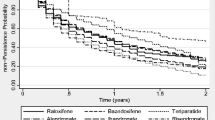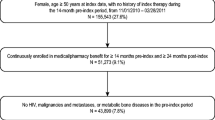Abstract
Low persistence with osteoporosis medication is associated with higher fracture risk. Previous studies estimated that 1-year persistence with osteoporosis medication is low. Our aim was to study persistence with osteoporosis medication among patients with long-term follow-up (to 5 years). The InterAction Database (IADB) was used to analyze persistence of 8610 Dutch patients initiating osteoporosis drugs between 2003 and 2011. Drugs under study were alendronate, risedronate, ibandronate, etidronate, raloxifene and strontium ranelate. Cumulative persistence rates were calculated after different time frames (3 months–5 years) using survival analysis. Multivariate Cox proportional hazard analyses were used to identify determinants of non-persistence. Furthermore, switching rates of persistent patients who initiated bisphosphonate therapy were analyzed. Persistence with osteoporosis therapy was 70.7 % (95 % CI, 69.7–71.7), 58.5 % (95 % CI, 57.4–59.6 %), 25.3 % (95 % CI, 24.1–26.5) after 6 months, 1 and 5 years, respectively. Determinants associated with higher risk to non-persistence within the first year were daily dosing regimen [HR, 1.76 (95 % CI, 1.46–2.14)], age <60 years [HR, 1.26 (95 % CI, 1.19–1.34)] and use of glucocorticoids [HR, 1.16 (95 % CI, 1.07–1.26)]. Monthly dosing schedule and use of generic brands of alendronate did not show a significant association with non-persistence. Approximately 4.0 % of patients initiating therapy with weekly alendronate or weekly risedronate switched therapy. Persistence with osteoporosis medication is low. Because low persistence is strongly associated with higher fracture risk, interventions to improve persistence are recommended. This study identified several patient groups in whom such interventions may be most relevant.


Similar content being viewed by others
References
Anonymous (1993) Consensus development conference: diagnosis, prophylaxis, and treatment of osteoporosis. Am J Med 94:646–650
Picavet HSJ (2004) Osteoporose en osteoporotische fracturen: omvang en gevolgen. [in Dutch]
Kwaliteitsinstituut voor de gezondheidszorg CBO (2011) Richtlijn Osteoporose en fractuurpreventie derde herziening. Utrecht [in Dutch]
Lips P, van Schoor NM (2005) Quality of life in patients with osteoporosis. Osteoporos Int 16:447–455
National Institute for Health and Clinical Excellence (NICE) (2010) Systematic reviews of clinical effectiveness prepared for the guideline ‘Osteoporosis: assessment of fracture risk and the prevention of osteoporotic fractures in individuals at high risk’. 2008
Ross S, Samuels E, Gairy K, Iqbal S, Badamgarav E, Siris E (2011) A meta-analysis of osteoporotic fracture risk with medication nonadherence. Value Health 14:571–581
Hiligsmann M, Rabenda V, Bruyère O, Reginster J (2010) The clinical and economic burden of non-adherence with oral bisphosphonates in osteoporotic patients. Health Policy 96:170–177
Penning-van Beest FJA, Goettsch WG, Erkens JA, Herings RMC (2006) Determinants of persistence with bisphosphonates: a study in women with postmenopausal osteoporosis. Clin Ther 28:236–242
Netelenbos JC, Geusens PP, Ypma G, Buijs SJE (2011) Adherence and profile of non-persistence in patients treated for osteoporosis–a large-scale, long-term retrospective study in The Netherlands. Osteoporos Int 22:1537–1546
van den Boogaard CHA, Breekveldt-Postma N, Borggreve SE, Goettsch WG, Herings RMC (2006) Persistent bisphosphonate use and the risk of osteoporotic fractures in clinical practice: a database analysis study. Curr Med Res Opin 22:1757–1764
Stuurman A, Hiddink E (2010) Pharmaceutical care interventions, initiated by computerized drug prescription monitoring, improve drug compliance [article in Dutch]. PW Wetenschappelijk Platform 4:128–135
Leufkens HG, Urquhart J (2006, 2007) Automated Pharmacy Record Linkage in The Netherlands. In: Anonymous (eds) Pharmacoepidemiology. Wiley, New York, pp 311–322
Tobi H, van den Berg P, de Jong-van den Berg L (2000) The InterAction Database: synergy of science and practice in pharmacy. In: Brause R, Hanisch E (eds) Medical data analysis. Springer, Berlin, pp 93–108
Schirm E, Monster TB, de Vries R, van den Berg PB, de Jong-van den Berg LT, Tobi H (2004) How to estimate the population that is covered by community pharmacies? An evaluation of two methods using drug utilisation information. Pharmacoepidemiol Drug Saf 13:173–179
Vegter S, Nguyen NH, Visser ST, de Jong-van den Berg LT, Postma MJ, Boersma C (2011) Compliance, persistence, and switching patterns for ACE inhibitors and ARBs. Am J Manag Care 17:609–616
Li L, Roddam A, Gitlin M, Taylor A, Shepherd S, Shearer A, Jick S (2012) Persistence with osteoporosis medications among postmenopausal women in the UK General Practice Research Database. Menopause 19:33–40
Cramer JA, Roy A, Burrell A, Fairchild CJ, Fuldeore MJ, Ollendorf DA, Wong PK (2008) Medication compliance and persistence: terminology and definitions. Value Health 11:44–47
Rabenda V, Hiligsmann M, Reginster JY (2009) Poor adherence to oral bisphosphonate treatment and its consequences: a review of the evidence. Expert Opin Pharmacother 10:2303–2315
Catalan VS, LeLorier J (2000) Predictors of long-term persistence on statins in a subsidized clinical population. Value Health 3:417–426
Landfeldt E, Strom O, Robbins S, Borgstrom F (2012) Adherence to treatment of primary osteoporosis and its association to fractures–the Swedish Adherence Register Analysis (SARA). Osteoporos Int 23:433–443
Cotte FE, Fardellone P, Mercier F, Gaudin AF, Roux C (2010) Adherence to monthly and weekly oral bisphosphonates in women with osteoporosis. Osteoporos Int 21:145–155
Cooper A, Drake J, Brankin E, PERSIST Investigators (2006) Treatment persistence with once-monthly ibandronate and patient support vs. once-weekly alendronate: results from the PERSIST study. Int J Clin Pract 60:896–905
Weiss TW, Henderson SC, McHorney CA, Cramer JA (2007) Persistence across weekly and monthly bisphosphonates: analysis of US retail pharmacy prescription refills. Curr Med Res Opin 23:2193–2203
Sheehy O, Kindundu CM, Barbeau M, LeLorier J (2009) Differences in persistence among different weekly oral bisphosphonate medications. Osteoporos Int 20:1369–1376
Ringe JD, Moller G (2009) Differences in persistence, safety and efficacy of generic and original branded once weekly bisphosphonates in patients with postmenopausal osteoporosis: 1-year results of a retrospective patient chart review analysis. Rheumatol Int 30:213–221
Strom O, Landfeldt E (2012) The association between automatic generic substitution and treatment persistence with oral bisphosphonates. Osteoporos Int 23:2201–2209
EMEA (2007) EMEA recommends changes in the product information for Protelos/Osseor due to the risk of severe hypersensitivity reactions
Rossini M, Bianchi G, Di Munno O, Giannini S, Minisola S, Sinigaglia L, Adami S, Treatment of Osteoporosis in clinical Practice (TOP) Study Group (2006) Determinants of adherence to osteoporosis treatment in clinical practice. Osteoporos Int 17:914–921
Landfeldt E, Lang A, Robbins S, Strom O (2011) Gastrointestinal tolerability and patterns of switching in patients treated for primary osteoporosis: the Swedish Adherence Register Analysis (SARA). Calcif Tissue Int 89:234–245
(2012) Volksgezondheid Toekomst Verkenning, Nationaal Kompas Volksgezondheid. RIVM, Bilthoven
Enlund H (1982) Measuring patient compliance in antihypertensive therapy–some methodological aspects. J Clin Hosp Pharm 7:43–51
Grymonpre R, Cheang M, Fraser M, Metge C, Sitar DS (2006) Validity of a prescription claims database to estimate medication adherence in older persons. Med Care 44:471–477
Gleeson T, Iversen MD, Avorn J, Brookhart AM, Katz JN, Losina E, May F, Patrick AR, Shrank WH, Solomon DH (2009) Interventions to improve adherence and persistence with osteoporosis medications: a systematic literature review. Osteoporos Int 20:2127–2134
Van Boven JFM, Hiddink EG, Stuurman-Bieze AGG, Postma MJ, Vegter S (2011) Structured medication surveillance for improving adherence to bisphosphonate therapy offers perspectives for cost-effective pharmaceutical care [article in Dutch]. PW Wetenschappelijk Platform 5:160–166
Acknowledgments
This study was funded by a research grant from GlaxoSmithKline.
Conflict of interest
None.
Author information
Authors and Affiliations
Corresponding author
About this article
Cite this article
van Boven, J.F.M., de Boer, P.T., Postma, M.J. et al. Persistence with osteoporosis medication among newly-treated osteoporotic patients. J Bone Miner Metab 31, 562–570 (2013). https://doi.org/10.1007/s00774-013-0440-2
Received:
Accepted:
Published:
Issue Date:
DOI: https://doi.org/10.1007/s00774-013-0440-2




